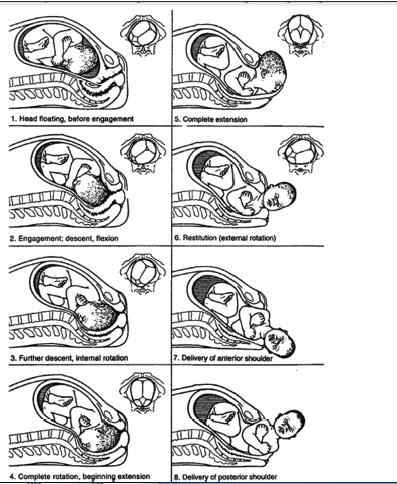Mechanism of labour
Mechanism of labour is the series of movement made by fetus through the birth canal. There are eight cardinal movements caused by the baby during childbirth:
- Engagement takes place when the fetal presenting part enters the pelvic inlet. A fetal head is said to be engaged when bi-parietal diameter enter the pelvic inlet and occiput is found at the level of the ischial spine in the mother's pelvis.
- Descend: refers to the progressive downward movement of the fetal part (commonly the head) through the pelvis. Since the pelvic cavity is enclosed with pelvic bones, when the uterus is actively pushing down, occasionally the fetal scalp bones undergo overlapping at the suture lines to allow the head to pass through the narrow space. This overlapping is called moulding
- Flexion of the head: occur during decent and resulted when a resistance felt by the baby's head against soft tissue and bones of the mother's pelvis. This brings about a flexion in the baby's head so that the chin touches the chest.
- Internal rotation: as the head reaches the pelvic floor, it typically rotates forward to accommodate the change in diameters of the pelvis. So the baby must rotate from lying sideways to turning its face towards the mother's backbone as the pelvic inlet had a greater diameter from right to left while at the pelvic outlet its diameter is greater from front to back. So the baby must rotate from lying sideways to turning its face towards the mother's backbone. It so called internal rotation as this movement occurs while the baby is inside of the mother.
- Extension: at this point, the head and neck extend escaping under the symphysis pubis (head and neck born extended)
- External rotation (restitution): after the head of the baby is born, the baby must rotate so that his/her face moves from facing the mother's backbone to facing either of her inner thighs (look at the figure below, number 6). This movement is called external rotation. The rotation is necessary as the baby's shoulders must fit around and under the mother's pubic bone.
- Lateral flexion of the body
- Expulsion of the fetus: the anterior (first born) shoulder moves out under the pubic bone. The mother's perineum becomes distended by the posterior (second) shoulder, which is then also born. The rest of the baby's body is then born (expulsion), with an upward motion of the baby's body assisted by the care provider. Look at the figure below (num. 6 and 7).

Fig. 2.2. The starting position and the seven cardinal movements of the baby as it descend through the birth canal. The small pictures show the position of the baby's head as if you were looking up the birth canal. (Source: WHO, 2008, Midwifery Education Module).
Last modified: Friday, 12 May 2017, 10:49 AM